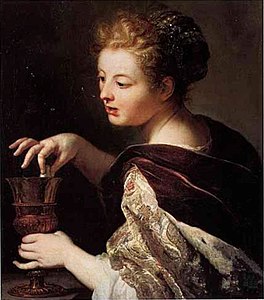Anthoni Schoonjans

Anthoni Schoonjans, nicknamed Parhasius[a] (1655 – 13 August 1726) was a Flemish painter known for his portraits as well as his history paintings. After training in Antwerp he had an international career, which saw him work in various countries in Europe including France, Italy, Germany, Austria, The Dutch Republic and Denmark. He was a court painter in Vienna, Copenhagen, Berlin and Düsseldorf.[1]
Life
Schoonjans was born in Ninove as the son of Joannes Schoonians, a wine merchant, and Anna de Gruytere and was baptized on 5 March 1655. He became in the Guild year 1668-1669 in Antwerp an apprentice of

In 1674 his mother met up with her son Anthoni in Reims. He left France and from 6 January 1675 he resided in Rome, where he familiarised himself with the Italian Baroque. He shared in Rome a residence with the flower painter Carel de Vogelaer in Via Margutta. Like his masters had done before him, he joined in 1674 the Bentvueghels, the society of mainly Flemish and Dutch artists working in Rome, and took the nickname "Parrhasius", likely after the famous painter of the late 5th century BC who worked in Athens.[2] In the year 1686 Antoon Schoonjans was mentioned in Lyon.[1]
By 1693 Schoonjans had moved to Vienna where he became the court painter of

In 1702 Schoonjans and his wife traveled to Berlin, apparently at the invitation of
In 1704 Schoonjans traveled to England where he painted the stairwell in
Later Schoonjans moved to Düsseldorf to work at the court of Johann Wilhelm, Elector Palatine who was a known art lover and had invited a great number of Dutch and Flemish painters to his court. He painted the portrait of the monarch and his wife. During this period he made many drawings, many of which are still in the Museum Kunstpalast in Düsseldorf. After the death of Elector Johann Wilhelm in 1716, Schoonjans returned to Vienna. He also worked in Slovenia in the "Križanke Church" together with Johann Michael Rottmayr. In 1726 he is recorded in Brno (Czech Republic) where he painted a "St. John of Nepomuk". He spent his final years in retirement in Perchtoldsdorf.[2]
Schoonjans also owned a house in Vienna where he died on 13 August 1726 of "innerlicher Brand" (internal inflammation).[6]
Work
Anthoni Schoonjans painted history pieces, mythological scenes, religious subjects and portraits.[2]
Gallery
- Paintings by Anthoni Schoonjans
-
Self-portrait
-
Portrait of crown prince Frederick William as David with a sling
-
Portrait of Johann Wilhelm, Elector Palatine
-
Cleopatra puts a pearl in the wine, 1706
-
The flagellation of Christ
Notes
- ^ Variant names: Anthoni Schoonjans, Anthonie Schoonjans, Antonie Schoonjans, Antoon Schoonjans,Antoine Schoonans, Antoine Squoniam; nicknames: Parrhasius and Parhasius
References
- ^ a b c d Anthon Schoonjans at the Netherlands Institute for Art History (in Dutch)
- ^ a b c d e f g h Kunstschilder Antoon Schoonjans (in Dutch)
- ^ Schoonians (La Scognians, Schonjans, la Schoonians, Scoonians, Sconianzin, Schvonianz, Sqonians, Schuonianz; geb. Schweyzer), Franziska Maria Regina in: Osterreichisches Musiklexikon (in German)
- ^ Jan van Gool, De Nieuwe Schouburg der Nederlantsche kunstschilders en schilderessen: Waer in de Levens- en Kunstbedryven der tans levende en reets overleedene Schilders, die van Houbraken, noch eenig ander schryver, zyn aengeteekend, verhaelt worden, The Hague, 1750 (in Dutch)
- ^ Barbara Beuys, 'Sophie Charlotte: Preußens erste Königin', Suhrkamp Verlag, 2018, pp. (in German)
- ^ WStLA, Totenbeschreibamt 30, fol. 212r
External links
 Media related to Anthoni Schoonjans at Wikimedia Commons
Media related to Anthoni Schoonjans at Wikimedia Commons





